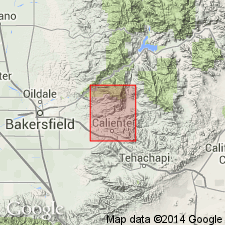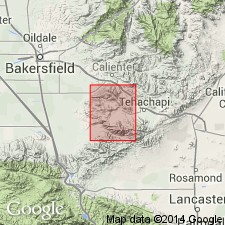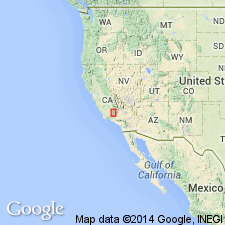
- Usage in publication:
-
- [Bena gravel]
- Modifications:
-
- Original reference
- Dominant lithology:
-
- Gravel
- Sand
- Clay
- AAPG geologic province:
-
- San Joaquin basin
Summary:
Pg. 12 (fig. 2), 38-40, pls. 1, 2, 3. Bena gravels; Bena formation. Series of light-gray to buff, poorly consolidated cobble and pebble gravel, arkosic sand, and interbedded gritty clay. Contains a 100+/- foot-thick bed of granite boulder gravel about 500 feet above its base. Total thickness at type locality about 2,500 feet. Conformably overlies Walker formation and Ilmon basalt (new) and unconformably underlies Kern River gravels in lower Caliente Canyon. Northwestward (outside of mapped area) in Cottonwood Canyon, overlies Freeman-Jewett shale [Freeman silt] and grades laterally into marine Olcese sandstone and Round Mountain silt. Southward, lower part of formation interfingers with and grades into Bealville fanglomerate. Considered a continental facies of lower and middle Miocene marine formations of eastern San Joaquin Valley. Interpreted to be of fluviatile origin but marine fossils found at several localities indicate local marine fingers. Age is considered early and middle Miocene.
Type locality: hills 3 mi southeast of Bena, in southwestern part of Breckenridge Mountain 15-min quadrangle, Kern Co., San Joaquin Valley, southern CA. Also well exposed from Bena northwestward into Cottonwood Canyon.
Source: Publication; US geologic names lexicon (USGS Bull. 1200, p. 296-297); GNU records (USGS DDS-6; Menlo GNULEX).

- Usage in publication:
-
- Bena Gravel*
- Modifications:
-
- Adopted
- Areal extent
- Age modified
- Dominant lithology:
-
- Gravel
- AAPG geologic province:
-
- San Joaquin basin
Summary:
Bena Gravel of Dibblee and Chesterman (1953) is adopted. Gravel in southwestern part of Cummings Mountain 15-min quadrangle is correlated with terrestrial Bena Gravel of Dibblee and Chesterman (1953). Thickness up to 800 feet. This gravel was formerly assigned to Santa Margarita Formation by Hoots (1930), which is marine. Unconformably overlies quartz diorite and underlies Chanac Formation. In Tejon Hills, underlies a marine white sand containing late Miocene molluscan fossils. Age is considered Miocene.
Type section: west-dipping 2-mi-long section that extends east from a point 1.5 mi south of Bena, Breckenridge Mountain 15-min quadrangle, Kern Co., southern CA.
Source: Modified from GNU records (USGS DDS-6; Menlo GNULEX).

- Usage in publication:
-
- Bena Gravel*
- Modifications:
-
- Areal extent
- Age modified
- Biostratigraphic dating
- AAPG geologic province:
-
- San Joaquin basin
Summary:
Paralitic facies of Bena Gravel, distinct from both alluvial fan facies characteristic of remainder of Bena Gravel and fully marine facies to southwest, is recognized. Detailed measured section of paralic facies from roadcuts along Breckenridge Road in sec.16 T29S R30E, M.D., is 162.2 ft thick. Columnar section and diagrammatic cross sections at Cottonwood Creek and Tejon Hills show positions of age controls. Bena contains foraminifers of Luisian (Miocene) age and marine diatoms of middle Miocene age. In Tejon Hills unit contains nonmarine mammals of early Clarendonian (late Miocene) age. Age of Bena is late early Miocene(?), middle Miocene, and late Miocene.
Source: GNU records (USGS DDS-6; Menlo GNULEX).
For more information, please contact Nancy Stamm, Geologic Names Committee Secretary.
Asterisk (*) indicates published by U.S. Geological Survey authors.
"No current usage" (†) implies that a name has been abandoned or has fallen into disuse. Former usage and, if known, replacement name given in parentheses ( ).
Slash (/) indicates name conflicts with nomenclatural guidelines (CSN, 1933; ACSN, 1961, 1970; NACSN, 1983, 2005, 2021). May be explained within brackets ([ ]).

